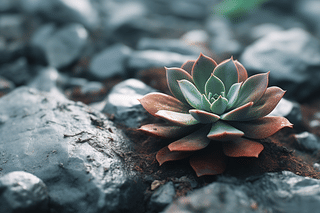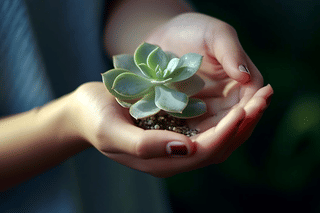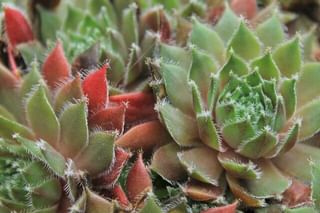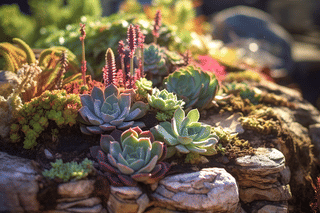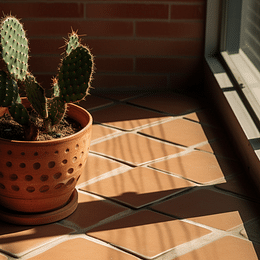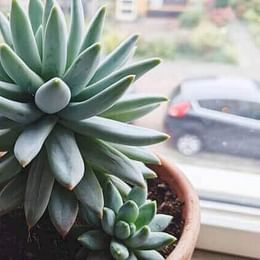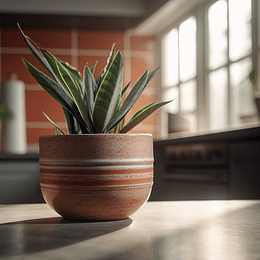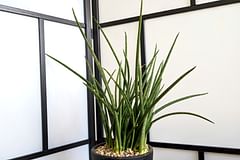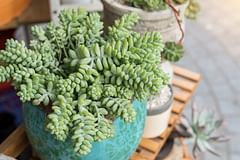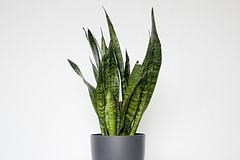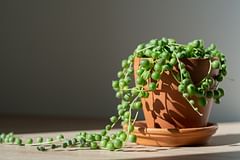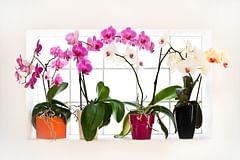How to care for a succulent (indoors)
Taking care of succulents is not always as easy at people make it seem. There are a few tricks to make taking care of them much easier. In this plant care guide, we'll go over what you need to know to take care of succulents successfully.
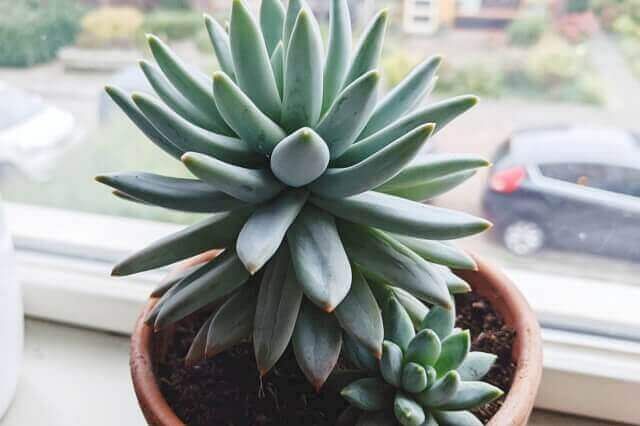
Whether you're a plant beginner or a plant veteran and you've already taken care of plants for many years, a succulent is a great type of plant to have around the house. There are many different varieties, but most of them require very similar plant care. In this guide, we're going to look at how to take care of succulents that love to sit in the sun, while keeping them indoors. We'll briefly go over if and how you can grow succulents outside because that could be the case depending on where you live, but we'll focus on taking care of succulents indoors.
We'll go over these topics that are important when taking care of a succulent:
This seems like a lot, but it's easier than it seems at first glance. Succulents are low-maintenance plants, but there are a few things you have to keep in mind to successfully grow these amazing plants in or around your house. We'll start with the most important parts of taking care of a succulent: watering and sunlight exposure.
Watering a succulent
If you're a new owner of a succulent, you may be wondering how often you should water it. The truth is, it depends on the type of succulent and the environment it's in. Generally, you don't need to water succulents as frequently as other plants because they store water in their leaves and stems.
Some species can survive up to two years without any water, making them great for those of you who may forget to water their plants regularly.
Watering Like in the Desert
Succulents naturally grow in warm and dry climates with a lot of sun. To successfully grow a succulent in your house, when you don't live in a warm and dry climate, you'll need to mimic its natural habitat the best you can.
One way to do this is to make sure your succulent doesn't get watered very often. It thrives when you don't water it for weeks at a time. Watering succulents too often will cause the plant to be overwatered and this will kill it. Too much water can cause root rot and other issues.
The ideal watering schedule
It's better to underwater your succulent than to overwater it. Many succulent owners find that they only need to water their plants once every two weeks or so. If your succulent is in a spot where it doesn't get any direct sunlight, you might have to water it even less.
In the summer it will need water more often than in the winter, as it's warmer and moisture evaporates more quickly. It's best to water it only once every two weeks in the summer and once per month in the winter.
As a general rule, it's best to wait until the soil is completely dry before watering your succulent. You can do this by sticking your finger about an inch and a half into the soil to see if it's damp. If it feels dry, it's time to water.
Signs your succulent is getting too much or too little water
It can happen that your succulent will get wrinkles in their leaves. You can also see this in the image at the top of this guide for some of the lower leaves of the succulent. When you see wrinkles in your succulent's leaves, this could mean your plant is either thirsty or has had too much water.
If the leaves start to feel soft, it's a sign that the plant is thirsty. Another indication is if the leaves start to droop or turn yellow. However, be careful not to confuse these signs with overwatering - if the leaves start to look mushy or brown, it's a sign that you've watered too much. If you need help reviving your succulent, you can have a look at How do you revive overwatered succulents?.
If you're unsure if your plant has had too much or too little water, think back to when the last time you watered it. If this was within the past two weeks, your plant is likely overwatered. If this was longer than that, your succulent is probably thirsty and you should water it soon.
Pots with drainage holes
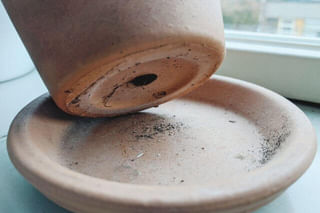
Another part of making sure you don't overwater your succulent is keeping your plant in a pot with a drainage hole. However, if you don't have one of these pots, you'll need to make sure that you water the succulent just enough that the soil can absorb the moisture and not have any excess water collected at the bottom of the pot.
This may take some trial and error. Drainage holes are ideal in a situation like this. When you water your succulent that's planted in a pot with a drainage hole, you should water it until it starts to drip out of the bottom of the pot. You should let your pot drip for about 5 minutes to make sure that any excess water has been drained from the pot.
If you're looking for more information about choosing the right pot for a succulent, have a look at How to pick the right pot for your succulent.
Sunlight exposure for a succulent
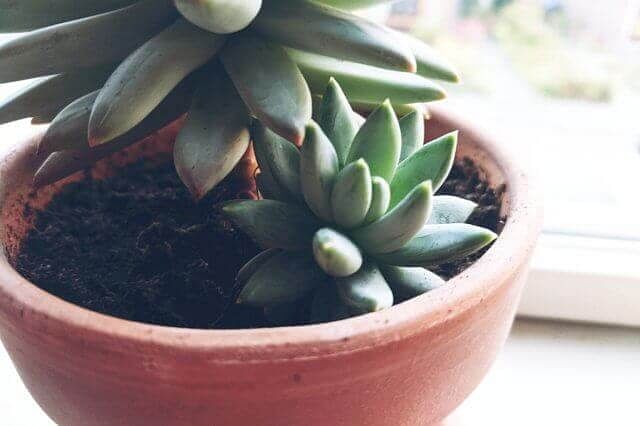 Sunlight exposure for a succulent, close to a window
Sunlight exposure for a succulent, close to a window
Most succulents, like cacti, grow in warm regions with direct sunlight exposure. There are a few succulents that require less sunlight, but most of the succulents require all the sunlight you can give them. Make sure to check if your specific succulent needs a lot of light and if so, put it on a windowsill with full sun exposure.
Check the temperature regularly
With the varying levels of sunlight exposure come varying temperatures. These temperatures are important to keep track of. If your succulent is in a warm and sunny spot all the time, you'll need to water it more often than when it doesn't get as much sunlight and the higher temperatures.
What does leggy growth mean on a succulent?
So most succulents love sunlight, but what happens if we don't give the succulent the sunlight exposure it wants? Your succulent will start to get taller and grow to one side. This behavior seems strange because most succulents are quite flat and wide plants. It's growing taller and leaning toward one side because it's looking for the sunlight it wants.
When you see your succulent grow taller like this, it's time to move it to a more well-lit spot. After you've moved it to a sunnier spot, you should notice that your succulent isn't growing any taller anymore. However, it's also not shrinking anymore.
Once your succulent has become leggy and stretched out, it won't return to its original size. So what can you do? One of the things you can do is propagate your succulent. We'll get into this further down in the guide. For now, it's important to know that you're not doing anything wrong when your succulent doesn't return to its old size, this is just what succulents do.
The ideal soil for your succulent
We've discovered that succulents love dry environments. One way to achieve this dry environment is watering your succulent very little, but a more effective way is to use a well-draining soil mix. The ideal soil for your succulent drains water quickly, so your succulent isn't sitting in water for too long. The best pre-packaged soil mix is a succulent or cactus soil mix.
Of course, you can also make this yourself by adding sand, large grains not fine sand, or perlite to your soil. This makes sure that the water gets drained quickly and not too much stays behind in the soil. Your succulent thrives in a dry environment and soil plays a vital role in this.
Fertilizing a succulent
When you want to help your plants grow a little more quickly, you can use fertilizer for this. Does this also work for succulents? Yes! You could fertilize a succulent once per month, but this is not needed. Ideally, you should fertilize it once per year, at the beginning of the growing season (spring). This way it can use the nutrients to grow right away.
Succulents are very slow-growing plants, so adding fertilizer can help a little, but it won't make your plant grow quickly compared to other houseplants. The best way to help your succulent steadily is to water it properly and give it plenty of light.
Propagating a succulent
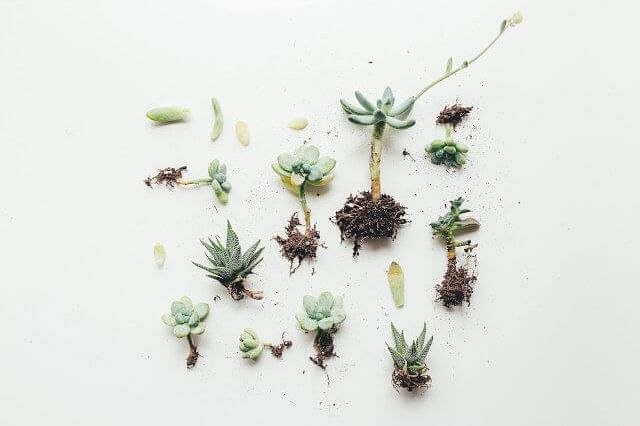 Photo by Corinne Kutz
Photo by Corinne Kutz
When we looked at light exposure for succulents, we discovered that you can propagate leggy and stretched succulents to make them look normal again. But how does this work? That's what we're going to find out in this section. Most succulents are very easy to propagate.
Example: when you have a succulent cutting, there are only 3 things you have to do:
- Wait until your succulent has grown a Callus on the section that was cut away from the parent plant (1-2 days in a sunny spot)
- Plant your succulent in the soil
- Water your succulent
When you have a leggy succulent, it's the same process. To get a good succulent cutting, you can cut the top off your succulent, remove some of the bottom leaves on the stem, and let the stem dry for two days. When you remove the bottom leaves from the stem, keep those around and let them dry for two days as well.
Succulent leaves are full of moisture and can often also grow their roots as you can see in the image below. These succulents are growing from individual leaves, but also from stem cuttings.
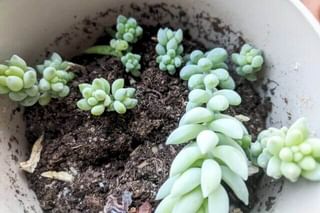
After two days, you can plant the top of the succulent and the leaves in the soil and water your plants. After a few weeks, your cuttings and leaves should grow their roots and after even more time, small succulents will start to grow from your cuttings. This does take a while, as succulents are slow-growing plants.
Propagating succulents in Leca or water
If you don't want to propagate your succulents in soil, but rather water or Leca, you are in luck. You can do that with succulents. The process is very similar to growing succulent cuttings in soil:
- Let the cutting callus off
- Place the callused-off part of the cutting in the water/Leca
- Wait for it to grow roots
Again, it will take a while before the roots grow, as succulents are still slow-growing plants, even in water or Leca.
Pruning succulents for healthy growth
Succulents are beautiful, low-maintenance plants that are popular among gardeners. But, like with all plants, pruning is an essential part of maintaining their health and appearance. Pruning succulents can promote healthy growth and keep the plants looking attractive. Here are a few tips on how to prune succulents:
- Start by sterilizing your pruning tools to prevent the spread of disease. Wipe them with rubbing alcohol or dip them in a solution of one part bleach to 10 parts water.
- Identify the areas of the succulent that need to be pruned. Look for yellowing or dead leaves, stems that are stretched or leggy, or parts of the plant that are overgrown and interfering with other parts.
- Use a sharp, clean pair of pruning shears or a knife to make the cuts. Cut just above a node or joint, where the plant will be able to produce new growth.
- Prune succulents in the spring or early summer when they are most actively growing. Avoid pruning during the dormant season (fall/autumn or winter) or during times of stress, such as when the plant is in flower or during extreme weather conditions.
- Don't be afraid to prune heavily. Succulents are resilient plants that can handle a lot of pruning. Pruning can encourage branching and thicker growth.
Pruning your succulent is one of the best ways to make it look better, but also keep it healthy in the long run. You can propagate any of the leaves that accidentally fall off or the stems that you've cut off.
Common pests and diseases
Succulents are some of the toughest plants you can get and they're not very likely to have to deal with any pests. But they are unfortunately not immune to pests and diseases.
Common pests on a succulent
Some of the most common pests that can afflict succulents include mealybugs, spider mites, and scale insects. These pests can cause damage ranging from small, white spots on leaves to significant damage to the plant's structure.
To prevent pest infestations on your succulents, it's important to keep your plants free of debris and to check them regularly for signs of bugs. You can also use natural pest control methods, such as introducing ladybugs to your garden or using neem oil to repel pests.
If you're going to spray your succulent with a liquid solution, make sure to do this in a (partially) shaded spot. The water drops on the leaves of a succulent could cause burn marks when it's sitting in the full sun.
Common diseases on a succulent
Diseases can also affect succulents, such as root rot or fungal infections. You can help to reduce the risk of root rot by making sure you have proper drainage for your succulent, as root rot thrives in moist environments. You can treat fungal infections with fungicides, but prevention is key. To avoid fungal infections, make sure that your plants have proper air circulation and aren't overcrowded.
Succulent care in the winter
In the winter, when it gets cold and less bright outside, your succulents will become dormant. The care you'll need to give them will be slightly different from what you have been doing during the spring and summer. You still have to make sure they get enough sunlight and they don't get too much water. The only difference is that you'll need to hold off on the number of times you water your succulent.
In the winter, the moisture doesn't evaporate as quickly as it does in the summer, so you should water it once per month instead of once per two weeks. Having excellent drainage is now even more important than in the summer since your plant will absorb less moisture and it won't be evaporated as quickly.
The lack of sunlight in the winter could mean that you have to move your succulents to a windowsill for them to still get enough sunlight. If your succulents are already on a windowsill, you don't have to move them, as they already get the maximum amount of light possible for that time of year. You can read more about taking care of plants in the winter by reading How to care for houseplants in the winter.
Growing succulents outside
This is a guide about taking care of succulents indoors, but plant owners will always wonder if they can grow their succulents outdoors. Whether you can grow your succulents outdoors depends on where you live.
If you live in a warm climate with a lot of sunlight and no frost in the winter, you can most likely grow succulents outside. If you live in a colder climate, you can only grow a select few "cold weather" succulents outside.
Winter hardy succulents by Gwen Weustink
These cold weather succulents are a different kind of succulents and they don't look a lot like the succulents you generally keep indoors. They're very tough succulents that don't have the fleshy leaves you expect succulents to have. These winter hardy succulents can survive even in freezing temperatures. If you try to grow normal, non-winter hardy, succulents outdoors in a colder climate, they will freeze during the winter and this will kill them.
Different types of succulents
Succulents are a very diverse group of plants that can grow in a lot of different environments. One of the biggest advantages of succulents is their ability to store water in their leaves, stems, or roots, which helps them survive in dry conditions.
One of the most popular types of succulents is the Echeveria, which has rosette-shaped leaves in a wide range of shades, from pale green to deep purple. Another favorite is the Aloe Vera, which you might know for its medicinal properties and spiky leaves that can range from green to grayish-blue. The Haworthia is a smaller succulent with distinctive rosettes of pointed leaves that can have stripes or spots.
Other types of succulents include the Jade Plant, which forms low-growing mats of small, rounded leaves, and the Sedum Morganianum, which has fleshy leaves that often turn reddish in bright sunlight. The Kalanchoe is another popular succulent with thick leaves that range from smooth to hairy, and the Agave is a large succulent with long, pointed leaves that can have serrated edges.
No matter what type of succulent you choose, they are all relatively easy to care for and make great additions to any indoor or outdoor garden. With their wide range of shapes, sizes, and colors, succulents are perfect for adding some unique and interesting texture to your plant collection.
Displaying your succulents at home or work
Succulents are a great addition to any home or office as they not only add a pop of greenery but are also easy to care for and require very little maintenance. When it comes to displaying these plants, there are plenty of creative ideas to choose from.
One popular way to display succulents is by using terrariums. Terrariums come in various shapes and sizes and can be made from glass, plastic, or metal. These mini-ecosystems allow you to create a small world for your succulent to thrive in and can be a beautiful addition to your workspace or home.
Another option is to use planters made from unique materials like driftwood, concrete, or even old tea tins or mason jars. These unconventional planters add a personalized touch to your decor and can be a great conversation starter.
If you're looking to maximize your space, consider using vertical gardens. These gardens can be hung on walls or even from the ceiling, bringing life to unused corners of your space.
Lastly, don't forget to get creative with how you group your succulents. Clustering a few different plants together can create a stunning display and add depth to your decor.
Using terrariums and enclosed environments
As we talked about in the previous on creative ways to display your succulents, terrariums are a popular choice. If you are planning to plant succulents in a terrarium or other enclosed environment, there are a few things you should keep in mind to ensure the success of your plants.
It's important to understand that succulents thrive in dry environments, so they can store water in their leaves and stems. For this reason, they are generally well-suited to life in terrariums.
However, there are a few things you should keep in mind when planting succulents in a terrarium. One important consideration is drainage. Succulents are prone to root rot if they are kept too wet, so it's important to make sure that your terrarium has proper drainage. This can be achieved by layering the bottom of the terrarium with rocks or gravel, or by adding a layer of activated charcoal.
Another important consideration is lighting. Succulents require plenty of bright, direct sunlight to thrive, so it's important to choose a location for your terrarium that receives plenty of natural light. If you're unable to provide enough natural light, you may need to add more light using artificial lighting.
It's also important to choose the right soil for your succulents. Succulents prefer soil that is well-drained and porous, so it's important to choose a soil mix that is specifically made for succulents. You may also want to add sand or perlite to the mix to improve drainage.
Conclusion
Succulents are amazing plants for beginners but also plant veterans. They're low-maintenance plants that will thrive when you forget about them for weeks at a time. There are a few things to keep in mind when taking care of succulents.
One of the most important things to keep in mind is that succulents are very sensitive to overwatering and cold temperatures. To keep succulents happy, you should water them very little and give them all the sunlight you can give them. You can grow some succulents outdoors depending on where you live.
If you live in a warm place with no frost in the winter, where it doesn't rain too much, you can grow your succulents outdoors, but otherwise, you can only grow winter-hardy succulents outdoors.
Succulents are a great addition to any plant collection, no matter how large your collection is at this moment. Succulents will grow slowly for many years and will be consistently beautiful plants for years when you keep them happy.
Thank you for reading this post! I hope it helps you to keep your plants healthy and beautiful! If you're looking for more guides on specific plants, you can always request a plant guide to get a guide for the plant you have trouble with.
Test your plant care knowledge
Quiz completed!
Want to learn more? Sign up for my newsletter to receive free tips in your inbox!
Sign up now!